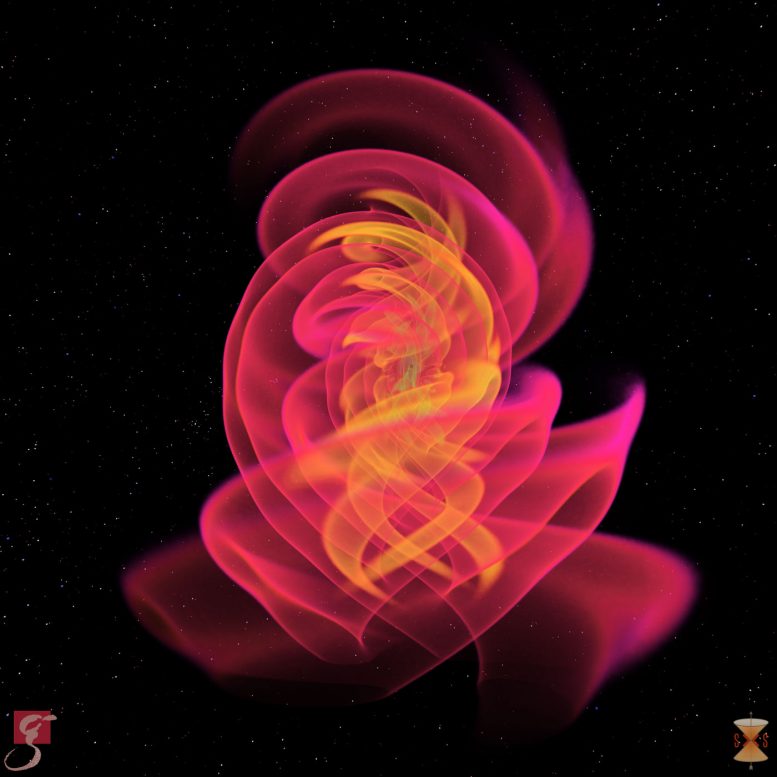
Space is moving: This numerical-relativistic simulation reflects the first observed fusion of two black holes measured by the Advanced LIGO detectors on September 14, 2015. © S. Ossokine, A. Buonanno (Max Planck Institute for Gravitational Physics, Simulating eXtreme Spacetimes Projekt, W. Benger (Airborne Hydro Mapping GmbH)
Scientists have carried out a closer analysis of previously recorded data from the LIGO and Virgo gravitational wave detectors, tracking down four new signals. They all originate from the collision of pairs of black holes. Once again, the researchers at the Max Planck Institute for Gravitational Physics in Potsdam and Hanover have made decisive contributions in key areas to the observations and their interpretation.
During the first observing run O1, from September 12, 2015, to January 19, 2016, gravitational waves from three BBH mergers were detected. The second observing run, which lasted from November 30, 2016, to August 25, 2017, yielded a binary neutron star merger and seven additional binary black hole mergers, including the four new gravitational wave events being reported now. The new events are known as GW170729, GW170809, GW170818, and GW170823 based on the dates on which they were detected. With the detection of four additional BBH mergers, the scientists learn more about the population of these binary systems in the universe and about the event rate for these types of coalescences.
The observed BBHs span a wide range of component masses, from 7.6 to 50.6 solar masses. The new event GW170729 is the most massive and distant gravitational-wave source ever observed. In this coalescence, which happened roughly 5 billion years ago, an equivalent energy of almost five solar masses was converted into gravitational radiation.
In two BBHs (GW151226 and GW170729) it is very likely that at least one of the merging black holes is spinning. One of the new events, GW170818, detected by the LIGO and Virgo observatories, was very precisely pinpointed in the sky. It is the best localized BBH to date: its position has been identified with a precision of 39 square degrees (195 times the apparent size of the full moon) in the northern celestial hemisphere.
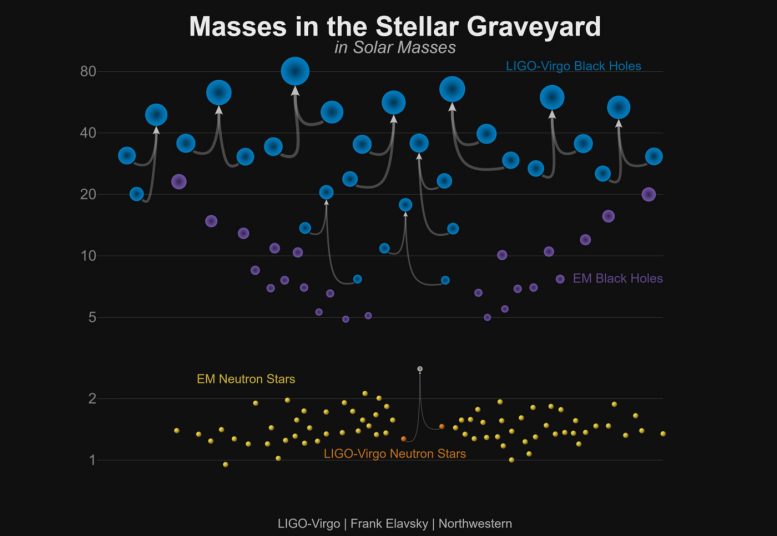
Panopticon of gravity traps: This illustration shows the masses of black holes, which were detected by gravitational waves (blue) and by observations in the electromagnetic spectrum (purple). In the lower part, the neutron stars can be seen which were also registered in ‘light’ (yellow). The two neutron stars that merged in the event GW170817, which were detected by gravitational waves, are depicted in orange. The numbers on the left indicate solar masses. © LIGO-Virgo / Frank Elavsky / Northwestern
The scientific papers describing these new findings present a catalog of all the gravitational wave detections and candidate events of the two observing runs as well as describing the characteristics of the merging black hole population. Most notably, the scientists find that almost all black holes formed from stars are lighter than 45 times the mass of the Sun.
“State-of-the-art waveform models, advanced data processing, and better calibration of the instruments, have allowed us to infer astrophysical parameters of previously announced events more accurately”, says Alessandra Buonanno, director of the “Astrophysical and Cosmological Relativity” division at AEI-Potsdam, and College Park professor at the University of Maryland. “I look forward to the next observing run in Spring 2019, where we expect to detect more than one black-hole merger every 15 days of data search!”
“I am happy that many of the advanced detector technologies developed at our GEO600 detector have helped to make the O2 run so sensitive and that in O3 another technology pioneered at GEO600, squeezed light, will be employed in LIGO and Virgo”, says Karsten Danzmann, director of the “Laser Interferometry and Gravitational Wave Astronomy” division at AEI-Hannover.
The eleven confidently detected gravitational waves were discovered using three independent analyses: two different so-called “matched-filter” analyses using relativistic models of gravitational waves from compact binary coalescences and one unmodeled search for short-duration bursts. In addition to these detections, the scientists presented a set of 14 marginal candidate events identified by the two matched-filter analyses.
Computer calculations model the gravitational waves, which LIGO measured in the two observation runs O1 and O2, as well as the black holes, which radiate the waves. The film shows the event horizons of the black holes and the corresponding gravitational wave signal below.
The third observing run (O3) of Advanced LIGO and Virgo is planned to start in early 2019. With further sensitivity upgrades to both LIGO and Virgo as well as the prospects of the Japanese gravitational-wave detector KAGRA joining the network possibly towards the end of O3, many tens of binary observations are anticipated in the coming years.
In O3, observational alerts triggered by gravitational-wave observations will be distributed publicly, allowing all astronomers – amateurs and professionals alike – to conduct follow-up observations.
References:
- “GWTC-1: A Gravitational Wave Transient Catalog of Compact Binary Mergers Observed by LIGO and Virgo during the First and Second Observing Runs” by The LIGO Scientific Collaboration, the Virgo Collaboration, 16 December 2018, Physical Review X.
DOI: 10.1103/PhysRevX.9.031040 - “Binary Black Hole Population Properties Inferred from the First and Second Observing Runs of Advanced LIGO and Advanced Virgo” by The LIGO Scientific Collaboration, the Virgo Collaboration, 18 December 2018,
DOI: 10.3847/2041-8213/ab3800


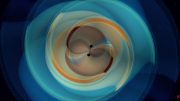
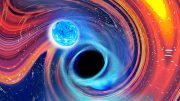
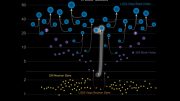
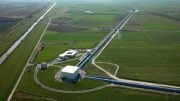
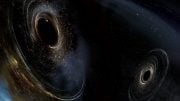
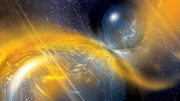
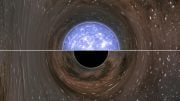
Be the first to comment on "LIGO and Virgo Reveal Four New Sources of Gravitational Waves"